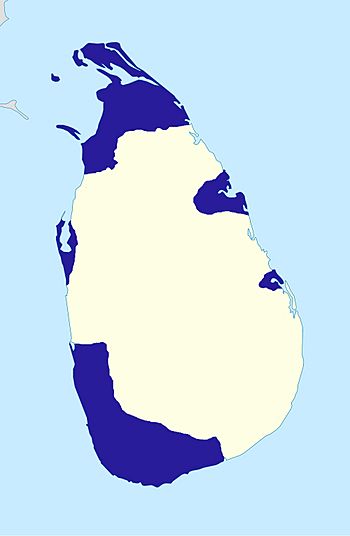Dutch Ceylon facts for kids
Quick facts for kids
Dutch Governorate of Ceylon
Nederlands-Ceylon
|
|||||||||||||
|---|---|---|---|---|---|---|---|---|---|---|---|---|---|
| 1640–1796 | |||||||||||||

Dutch territorial expansion in Ceylon 1690.
|
|||||||||||||
| Status | Governorate | ||||||||||||
| Capital | Galle Colombo |
||||||||||||
| Common languages | Sinhala, Tamil, and Dutch | ||||||||||||
| Governor | |||||||||||||
|
• 1640–1640
|
Willem Jacobszoon Coster | ||||||||||||
|
• 1794–1796
|
Johan van Angelbeek | ||||||||||||
| Historical era | Imperialism | ||||||||||||
|
• Established
|
13 March 1640 | ||||||||||||
|
• Disestablished
|
16 February 1796 | ||||||||||||
|
|||||||||||||
| Today part of | |||||||||||||
Dutch Ceylon was a part of Sri Lanka that was controlled by the Dutch East India Company. This happened between 1640 and 1796. At that time, Sri Lanka was known as Ceylon. The name in Sinhala is ලන්දේසි ලංකාව (Landesi Lankava).
In the early 1600s, Ceylon was divided. Some parts were ruled by the Portuguese. Other parts were controlled by local kingdoms. These kingdoms often fought among themselves. The Portuguese rule was very hard on the people. Because of this, the king of Kandy asked the Dutch for help. The Dutch East India Company then took over the country.
Contents
What Was Dutch Ceylon?
Dutch Ceylon was a governorate, which means it was a territory ruled by a governor. It was part of the larger Dutch Empire. The main goal of the Dutch was to gain control of trade. They also wanted to stop the Spanish and Portuguese from becoming too powerful in the region.
How the Dutch Arrived
The Dutch arrived in Ceylon because the local king of Kandy needed help. The Portuguese had taken control of many coastal areas. They were also trying to expand their power. The king of Kandy hoped the Dutch would help him push the Portuguese out.
- In 1602, the first Dutch explorer, Joris van Spilbergen, arrived in Ceylon. He met with King Vimaladharmasurya I of Kandy.
- The Dutch and the Kingdom of Kandy made an agreement. The Dutch would help fight the Portuguese. In return, they would get trading rights.
- The Dutch captured Galle in 1640. This was a very important port city. It marked the start of Dutch control in Ceylon.
- They slowly took over more areas from the Portuguese. By 1658, the Dutch had taken all Portuguese strongholds.
Life Under Dutch Rule
The Dutch East India Company managed Dutch Ceylon. They focused on trade, especially in spices like cinnamon. Cinnamon was very valuable in Europe.
- The Dutch built many forts and trading posts along the coast. These helped them protect their trade routes.
- They introduced new laws and ways of governing. These were based on Dutch systems.
- The main cities were Galle and later Colombo. These cities became important centers for trade and administration.
- The Dutch controlled the coastal areas. However, they never fully controlled the central mountain regions. The Kingdom of Kandy remained independent in the middle of the island.
The End of Dutch Rule
Dutch rule in Ceylon lasted for over 150 years. But things changed in the late 1700s.
- During the French Revolutionary Wars in Europe, the Netherlands was invaded by France.
- Great Britain, a rival of France, saw this as a chance to take over Dutch colonies.
- In 1795, the British attacked Dutch Ceylon. They wanted to prevent France from getting control of it.
- The British captured Colombo in 1796. This marked the end of Dutch rule in Ceylon.
- Ceylon then became a British colony, known as British Ceylon.
Images for kids
-
A map of the lands of the Habsburg kings in the period of personal union of Portugal (blue) and Spain (red/pink) (1580–1640)
See also
 In Spanish: Ceilán neerlandés para niños
In Spanish: Ceilán neerlandés para niños












